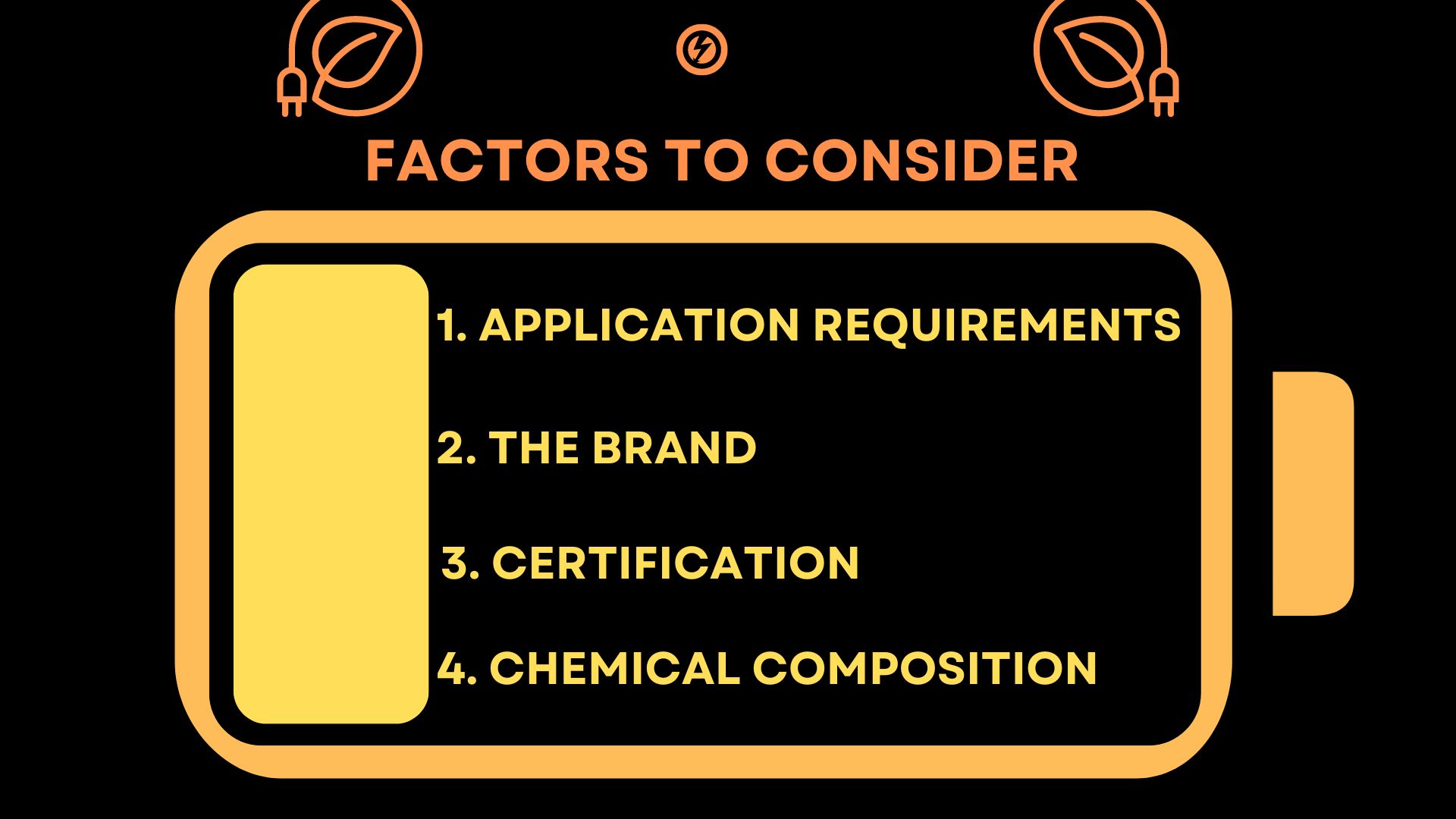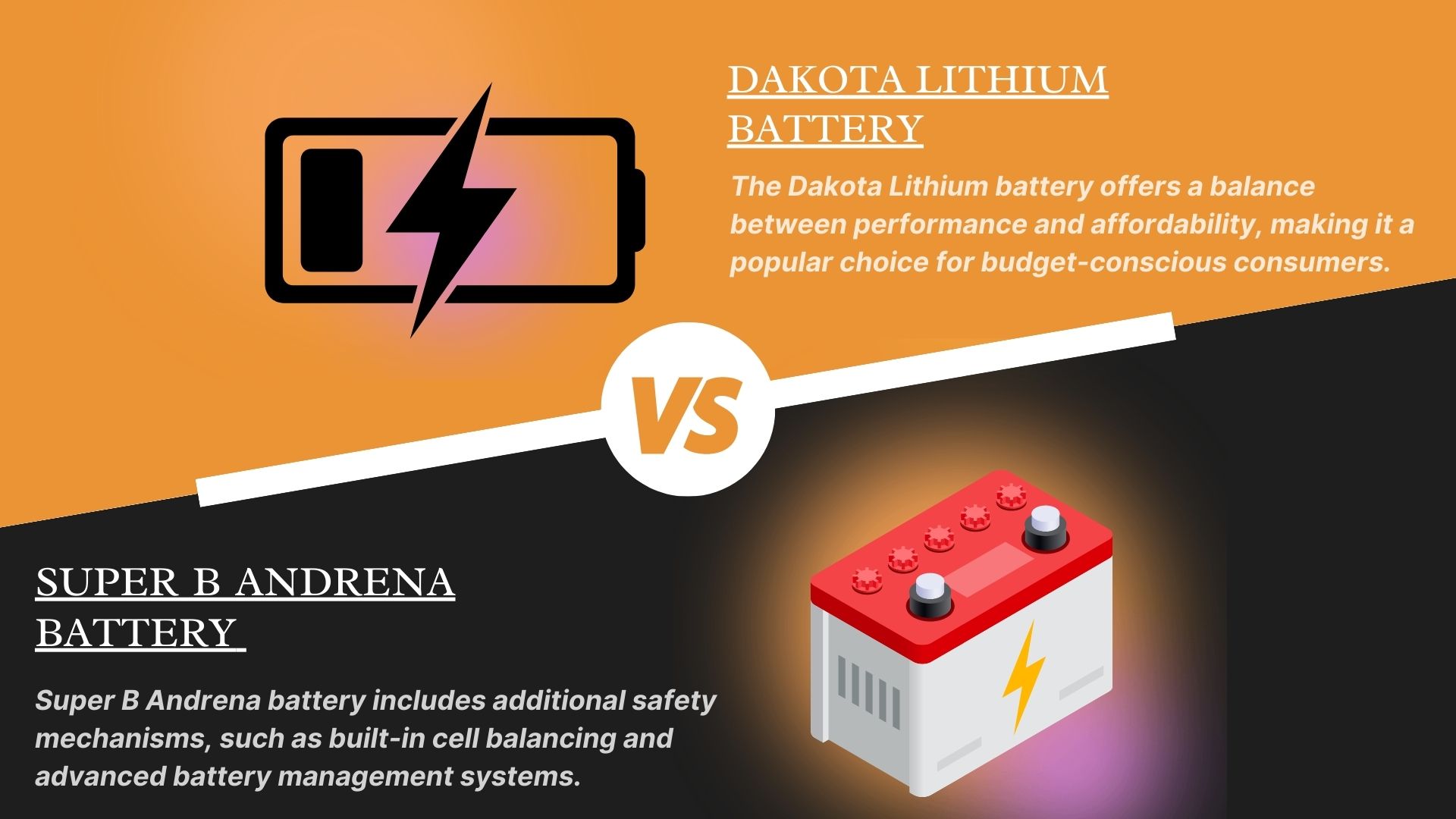In the world of batteries, we are going to compare Super B Andrena 12V10AH (10P) vs Dakota Lithium 12v 10Ah Battery. They both have gained significant recognition for their high-performance 12V10Ah batteries.
These batteries are widely used in various applications, ranging from electric vehicles to solar energy storage systems.
In this comprehensive comparison guide, we will evaluate the Super B Andrena 12V10AH (10P) battery vs Dakota Lithium 12V10Ah battery, highlighting their features, specifications, performance, and application suitability.
By the end of this article, you will have a clear understanding of which battery suits your specific needs. So, with further ado, let’s dive into the topic and before discussing the difference let’s look at the factors you should keep in mind before choosing a 12V Lithium battery for different applications.

The following are the main factors you should consider before buying a lithium battery:
- Power and Application Requirements
- The Brand
- Certification
- Chemical Composition of Lithium Batteries
1. Power and Application Requirements:
Establish the precise application for which the lithium battery is required. Think about the power needs, voltage compatibility, and discharge rate required by your system or devices.
Make sure the battery you purchase can efficiently satisfy those needs because different applications may have different power requirements.
2. The Brand:
Despite the fact that the first lithium-ion battery for use in commercial products was created more than 30 years ago, LFP batteries are still a relatively young technology when it comes to high-power applications. Therefore, in order to stay ahead of the competition, top-tier lithium battery producers have had to continuously develop and increase their technical expertise.
Compared to lead-acid batteries, lithium batteries use far more advanced technology, therefore creating the highest-quality lithium batteries demands a very high level of technical competence and knowledge.
The experience of the brand or company is crucial when choosing a lithium battery brand, and it’s necessary to take into account the company’s robust operations and financial stability as well.
3. Certification:
For lithium batteries to fulfill UN38.3 criteria and be approved for transportation, a thorough testing and certification process is required.
There are numerous goods on the market, however, that do not adhere to the UN38.3 standard, and certification is the seller’s obligation.
Through eight rounds of testing, including temperature, vibration, shock, short circuit, impact, crush, and forced discharge, the battery must pass without rupturing, leaking, disassembling, or catching fire in order to be authorized. An essential consumer safety measure is provided by these tests.
4. Chemical Composition of Lithium Batteries:
The safety and endurance of your energy storage system are directly impacted by the lithium battery chemistry, which is crucial.
In addition to lithium iron phosphate (LFP or LiFePO4), lithium nickel manganese cobalt oxide (NMC), lithium cobalt oxide (LCO), and lithium nickel cobalt aluminum oxide (NCA), there are several other lithium battery chemistry alternatives to be aware of.
Cobalt-based or non-cobalt-based lithium batteries (such as LiFePO4 or LFP) are the two types of lithium battery chemistries that are most often employed, with the latter being the safest, most ecologically friendly, and longest-lasting lithium battery chemistries on the market.
In contrast to the cobalt-oxide bond that cobalt-based lithium batteries like LCO, NMC, and NCA have, the oxygen and phosphorus atoms in LFP batteries have a strong covalent relationship.
Because of the phosphate-oxide bond’s improved stability, this is favorable. On the other side, lithium-cobalt batteries that have been damaged or overcharged can generate a lot of heat and pose a fire risk.
LiFePO4 batteries may be mounted on their side and in compartments with less room due to their improved chemistry, which also increases safety.
A Comprehensive Comparison Guide

With the help of this table, you will be able to understand the main difference between Super B Andrena 12V10AH (10P) vs Dakota Lithium 12v 10Ah Battery.
| Features | Super B Andrena 12V10AH (10P) | Dakota Lithium 12V10Ah |
| Capacity | 10Ah | 10Ah |
| Voltage | 12V | 12V |
| Weight | Lighter | Comparatively heavier |
| Size | Compact | Standard size |
| Lifespan | Extended cycle life | Longer overall lifespan |
| Charging Time | Faster charging | Standard charging time |
| Safety Features | Built-in cell balancing | Standard safety mechanisms |
| Price | Higher price range | More cost-effective |
| Application Suitability | Electric motorcycles, drones, portable power stations | Backup power systems, solar energy storage, remote monitoring devices |
1. Capacity and Voltage
The Super B Andrena 12V10AH (10P) vs Dakota Lithium 12v 10Ah Battery share the same voltage and capacity. Both batteries offer a 12V output and have a capacity of 10Ah.
This capacity ensures a reliable power supply for extended periods, making them ideal for demanding applications that require consistent energy delivery.
Whether you need lithium batteries for motorbikes, marine electronics, or off-grid systems, both batteries provide sufficient capacity and voltage to meet your requirements.
2. Weight and Size
When it comes to weight and size, the Super B Andrena 12V10AH (10P) battery takes the lead. Thanks to its advanced lithium-ion technology, it is considerably lighter and more compact compared to the Dakota Lithium 12V10Ah battery.
The Super B Andrena battery’s lightweight design offers significant advantages, especially in applications where weight reduction is critical, such as in the aerospace industry or electric motorcycles.
Additionally, the smaller size of the Super B Andrena battery allows for easier installation and greater flexibility in space-constrained applications.
3. Lifespan and Cycle Life
Super B Andrena 12V10AH (10P) vs Dakota Lithium 12v 10Ah Battery offers an impressive lifespan and cycle life, ensuring long-term reliability.
The Super B Andrena battery boasts an extended cycle life, making it suitable for applications that require frequent charging and discharging cycles, such as electric vehicles or renewable energy systems.
On the other hand, the Dakota Lithium battery excels in overall lifespan, providing a longer operational life before reaching the end of its serviceable life.
This makes it an ideal choice for applications where longevity is a top priority, such as backup power systems or remote monitoring devices.
4. Charging Time
When it comes to charging time, the Super B Andrena 12V10AH (10P) battery takes the lead over the Dakota Lithium 12V10Ah battery.
The Super B Andrena battery incorporates advanced charging technology that enables faster recharging, resulting in reduced downtime and a more efficient power supply.
This feature proves particularly beneficial in applications where quick recharging is essential, such as electric vehicles or portable devices that require frequent use.
Users can spend more time utilizing their devices or vehicles and less time waiting for the battery to recharge.
5. Safety Features
Both the Super B Andrena 12V10AH (10P) vs Dakota Lithium 12v 10Ah Battery incorporates essential safety features to protect against overcharging, short circuits, and thermal issues.
These safety mechanisms ensure the reliable and secure operation of the batteries, reducing the risk of accidents or damage.
However, the Super B Andrena battery includes additional safety mechanisms, such as built-in cell balancing and advanced battery management systems. These extra safety features provide an additional layer of protection for your valuable equipment, enhancing overall system safety.
6. Price and Value for Money
When it comes to price and value for money, the Dakota Lithium 12V10Ah battery tends to be more cost-effective compared to the Super B Andrena 12V10AH (10P) battery.
The Dakota Lithium battery offers a balance between performance and affordability, making it a popular choice for budget-conscious consumers.
However, it is important to consider the specific requirements of your application and determine whether the additional features and benefits offered by the Super B Andrena battery justify the price difference.
If the lightweight design, advanced safety features, and faster charging times align with your needs, the Super B Andrena battery may offer better long-term value despite the higher upfront cost.
7. Application Suitability
The choice between these batteries ultimately depends on the specific application. If weight, size, and fast charging are crucial factors, the Super B Andrena 12V10AH (10P) battery is the preferred choice.
Its lightweight design, compact size, and advanced charging technology make it an excellent option for applications such as electric motorcycles, drones, or portable power stations.
On the other hand, if you prioritize longevity and cost-effectiveness, the Dakota Lithium 12V10Ah battery is an excellent option for backup power systems, solar energy storage, or remote monitoring devices.
It is clear from the comparison of the Dakota Lithium 12V10Ah battery and the Super B Andrena 12V10AH (10P) battery that they both offer comparable specs and are appropriate for a range of applications.
With its lightweight construction, improved charging efficiency, and somewhat longer cycle life, the Super B Andrena battery stands out.
The Dakota Lithium battery, on the other hand, specializes in toughness and is built to survive harsh environments.
The decision between these two batteries ultimately comes down to your individual requirements and tastes.
When making a choice, take into account aspects including weight, cycle life, cost, and application requirements.
The Dakota Lithium battery and the Super B Andrena Lithium batteries are both trustworthy and effective power sources that will work well in a variety of applications.
FAQs:
Are these batteries environmentally friendly?
Compared to conventional lead-acid batteries, lithium batteries, such as the Super B Andrena and Dakota Lithium batteries, are usually seen to be more ecologically friendly. To reduce the environmental effect of lithium batteries, correct disposal, and recycling practices must be followed.
Can I use these batteries interchangeably in any application?
Both batteries have a wide variety of uses in mind. To make sure the battery you purchase is appropriate, you should take into account things like voltage compatibility, capacity, and the unique needs of your application.
Can these batteries be used in extreme temperatures?
Dakota Lithium and Super B Andrena batteries are both made to function in a broad temperature range. To make sure they are appropriate for your intended application, it is advised to verify the manufacturers’ precise temperature requirements.


